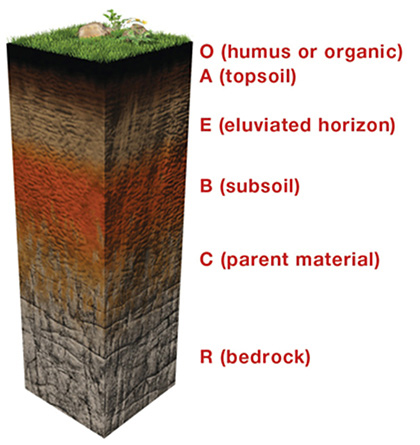
Credit: USDA (public domain), via Wikimedia Commons
Here’s my vote for most underappreciated Earth system: dirt. All terrestrial life depends on it, but almost no one gives it any love.
The soil is a place where air, water, rock, and life intersect. It’s the surface we live on, farm in, build upon, and are often buried in when we die.
For dirt to be good soil, it needs some special ingredients: decomposed bedrock—which gives soil its minerals; organics—from dead plant and animal matter; and life—lots of it.
In a single shovelful of dirt there are trillions of creatures, from earthworms to bacteria, and thousands of feet of fungus.
Soil’s most important job is to provide plants their nutrients and a place to anchor their roots. But it does many other amazing things.
It absorbs, stores, and releases most of the water on Earth’s surface and filters it before it moves to an aquifer.
By managing water, soil limits surface runoff and flooding.
Soil stores and recycles minerals and other nutrients, so that living things can use them again and again.
It absorbs and emits gases like carbon dioxide, methane, and water vapor, constantly interacting with the atmosphere.
It even provides building materials, like sand for concrete, clay for bricks, and lumber from trees growing on healthy soil.
How we choose to take care of our dirt—how we farm it, keep it free from pollutants, and recognize that it’s a living ecosystem—impacts the health of all other life on Earth.
Background
Synopsis: Soil forms the “living skin” of our planet. Your health is connected to soil because 95% of our food depends on soil ecosystems. Without soil, terrestrial life would not exist on Earth. Soil mismanagement has important consequences for the health of societies.
- The ecosystem of soil is called the pedosphere, an amazing dynamic zone that only exists where constant interaction occurs across the atmosphere, biosphere, lithosphere, and hydrosphere—the intersection of air, life, rock, and water, more recently called the critical zone.
- Soil has several important functions:
- Soil microbes provide plants with necessary nutrients. Plants convert sunlight and CO2 into sugars and oxygen, and then microorganisms consume the sugars and feed plants the nutrients they need. When we fertilize, we are feeding the soil, not the plants!
- Soils support plants by providing roots with anchorage.
- Soils absorb, store, release, and purify most of the water in terrestrial systems. They act as a living filter to clean water before it moves into an aquifer.
- Soils sequester and recycle nutrients, including carbon, so that living things can use them over and over again. Carbon sequestered in permafrost soils is the subject of intense study because these deposits thaw in response to changing climate.
- Soils absorb and emit gases like carbon dioxide, methane, and water vapor, interacting dynamically with the atmosphere.
- Soils are rich habitats for organisms from earthworms to microbes—a single teaspoon may contain a billion bacteria and thousands of protozoans, as well as several yards of fungal filaments. If soils are compressed or waterlogged so that they can’t hold air, their microbiome suffers.
- Soils provide societies with building materials, from bricks and sand to trees that grow on healthy soils.
- By absorbing water, soils mitigate surface runoff and flooding, protecting downstream infrastructure and people from flood damage.
- Soil consists of void space, which may be filled by air or water, and solids, including minerals, organic material, and living organisms.
- Soil is produced through time from its bedrock through physical, chemical, and biological processes that depend on time, climate, steepness, plant assemblages, and original composition of the parent material.
- Soil consists of several layers, depending on many factors, including soil age:
- O – Humus, or organic, layer is decomposing organic matter.
- A – Topsoil is a mixture of organic material and minerals from the parent material. Gardeners focus their efforts on topsoil.
- E – Eluviated horizon may exist in older soils as a leached layer of sand or silt.
- B – Subsoil is much lower in organic content than topsoil, but deep plant roots extend to this layer for water and nutrients that have percolated through the topsoil.
- C – Weathered parent material is decomposed bedrock that lacks organics and may extend fairly deep into Earth.
- R – Parent material on which soil forms, including, for example, granite, schist, basalt, limestone, or sandstone. The characteristics of soil also depend on the minerals in the bedrock.
- Soil texture is important. Sandy soils hold less water or nutrients but tend to release water and nutrients more easily; clay soils, on the other hand, can retain more water, but that water is more tightly bound, sometimes leading to stressed vegetation. The textural makeup of loam is about 40% sand, 40% silt, and 20% clay—just right for plants to stretch out their roots!
- Today, most of the living soil on Earth is younger than the Pleistocene (2.6 million years ago), and none is older than the Cenozoic (65 million years ago); however, fossil soils have been preserved all the way back to the Archean (2.5 to 4 billion years ago).
- When geologic material can support plant life and has undergone physical, chemical, and biological processes, it is known as soil. When it’s brought inside on your shoes or it’s under your fingernails, though, then it’s simply…dirt!

